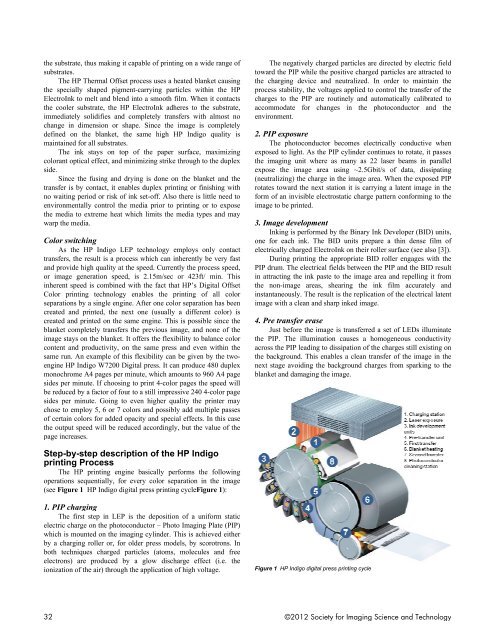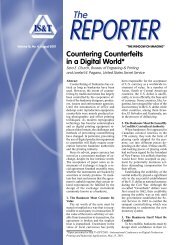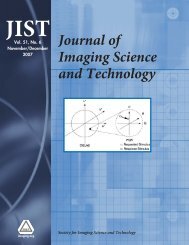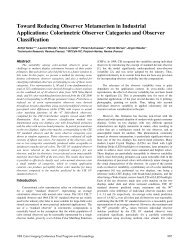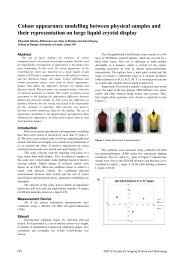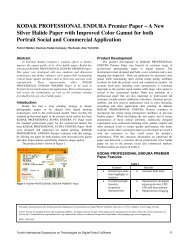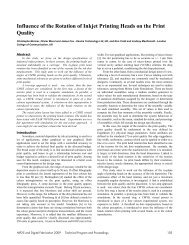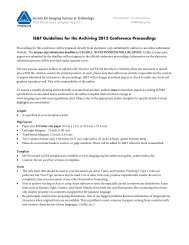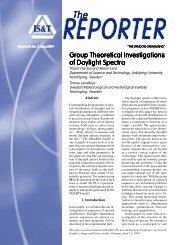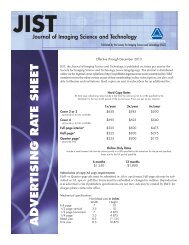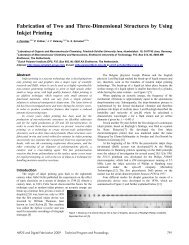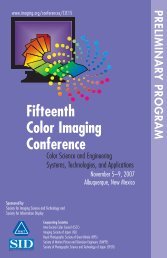HP-Indigo Technology and its Application to Photo Printing
HP-Indigo Technology and its Application to Photo Printing
HP-Indigo Technology and its Application to Photo Printing
Create successful ePaper yourself
Turn your PDF publications into a flip-book with our unique Google optimized e-Paper software.
the substrate, thus making it capable of printing on a wide range<br />
of<br />
substrates.<br />
The <strong>HP</strong> Thermal Offset process uses a heated blanket causing<br />
the specially shaped pigment-carrying particles within the <strong>HP</strong><br />
ElectroInk <strong>to</strong> melt <strong>and</strong> blend in<strong>to</strong> a smooth film. When it contacts<br />
the cooler substrate, the <strong>HP</strong> ElectroInk adheres <strong>to</strong> the substrate,<br />
immediately solidifies <strong>and</strong> completely transfers with almost no<br />
change in dimension or shape. Since the image is completely<br />
defined on the blanket, the same high <strong>HP</strong> <strong>Indigo</strong> quality is<br />
maintained for all substrates.<br />
The ink stays on <strong>to</strong>p of<br />
the paper surface, maximizing<br />
colorant optical effect, <strong>and</strong> minimizing strike through <strong>to</strong> the duplex<br />
side.<br />
Since the fusing <strong>and</strong> drying is done on the blanket <strong>and</strong> the<br />
transfer is by contact, it enables<br />
duplex printing<br />
or finishing with<br />
no waiting period or risk of ink set-off. Also there is little need<br />
<strong>to</strong><br />
environmentally control the media prior <strong>to</strong> printing or <strong>to</strong> expose<br />
the media <strong>to</strong> extreme heat which lim<strong>its</strong> the media types <strong>and</strong> may<br />
warp the media.<br />
Color switching<br />
As the <strong>HP</strong><br />
<strong>Indigo</strong> LEP technology employs only contact<br />
transfers, the result is a process which can inherently be very fast<br />
<strong>and</strong> provide highh quality at the speed. Currently the process speed,<br />
or image generation speed, is<br />
2.15m/sec or 423ft/ min. This<br />
inherent speed is<br />
combined with<br />
the fact that <strong>HP</strong>’s Digital Offset<br />
Color printing technology enables the printing of all color<br />
separations by a single engine. After one color separation has been<br />
created <strong>and</strong> printed, the next one (usually a different color)<br />
is<br />
created <strong>and</strong> printed on the same<br />
engine. This is<br />
possible since the<br />
blanket completely transfers the<br />
previous image, <strong>and</strong> none of the<br />
image stays on the blanket. It offers the flexibility <strong>to</strong> balance color<br />
content <strong>and</strong> productivity, on the<br />
same press <strong>and</strong> even within the<br />
same run. An example of this flexibility can be given by the two-<br />
engine <strong>HP</strong> <strong>Indigo</strong><br />
W7200 Digital press. It can produce 480 duplex<br />
monochrome A4<br />
pages per minute, which amounts <strong>to</strong> 960 A4 page<br />
sides per minute. If choosing <strong>to</strong> print 4-color pages the speed will<br />
be reduced by a fac<strong>to</strong>r of four <strong>to</strong> a still impressive 240 4-color page<br />
sides per minute. Going <strong>to</strong> even higher quality the printer may<br />
chose <strong>to</strong> employ 5, 6 or 7 colors<br />
<strong>and</strong> possibly add multiple passes<br />
of certain colors for added opacity <strong>and</strong> special effects. In this case<br />
the output speed<br />
will be reducedd accordingly, but the value of the<br />
page increases.<br />
The negatively charged particles are directed by electric field<br />
<strong>to</strong>ward the PIP while the positive charged particles are attracted <strong>to</strong><br />
the charging device <strong>and</strong> neutralized. In order <strong>to</strong> maintain the<br />
process stability, the voltages applied <strong>to</strong> control the transfer of the<br />
charges <strong>to</strong> the PIP are<br />
routinely <strong>and</strong> au<strong>to</strong>matically calibrated <strong>to</strong><br />
accommodate for changes in the pho<strong>to</strong>conduc<strong>to</strong>r <strong>and</strong> the<br />
environment.<br />
2. PIP exposure<br />
The pho<strong>to</strong>conduc<strong>to</strong>r becomes electrically conductive when<br />
exposed<br />
<strong>to</strong> light. As the<br />
PIP cylinder continues <strong>to</strong> rotate, it passes<br />
the imaging unit where as many as 22 laser beams<br />
in parallel<br />
expose the image area using ~2.5Gbit/s of data, dissipating<br />
(neutralizing) the charge in the image area. When the exposed PIP<br />
rotates <strong>to</strong>ward the next station it is carrying a latent image in the<br />
form of<br />
an invisible electrostatic charge pattern conforming <strong>to</strong> the<br />
image <strong>to</strong><br />
be printed.<br />
3. Image development<br />
Inking is performed by the Binary Ink Developer (BID) un<strong>its</strong>,<br />
one for each ink. The<br />
BID un<strong>its</strong> prepare a thin dense film of<br />
electrically charged ElectroInk on their roller surface (see also [3]).<br />
During printing the appropriate BID roller engages with the<br />
PIP drum. The electrical fields between<br />
the PIP <strong>and</strong> the<br />
BID result<br />
in attracting the ink paste <strong>to</strong> the image<br />
area <strong>and</strong> repelling it from<br />
the non-image areas, shearing the ink film accurately <strong>and</strong><br />
instantaneously. The result is the replication of the electrical latent<br />
image with a clean <strong>and</strong> sharp inked image.<br />
4. Pre transfer erase<br />
Just before the image is transferred a set of LEDs illuminate<br />
the PIP. The illumination causes a homogeneous conductivity<br />
across the PIP leading <strong>to</strong> dissipation of the charges stilll existing on<br />
the background. This enables a clean transfer of the image in the<br />
next stage avoiding the<br />
background charges from sparking <strong>to</strong> the<br />
blanket <strong>and</strong> damaging the image.<br />
Step-by-step description of the <strong>HP</strong><br />
<strong>Indigo</strong><br />
printing Process<br />
The <strong>HP</strong> printing engine basically performs the following<br />
operations sequentially, for every color separation in the image<br />
( see Figure 1 <strong>HP</strong><br />
<strong>Indigo</strong> digital press printing cycleFigure 1):<br />
1. PIP charging<br />
The first step in LEP is the deposition of a uniform static<br />
electric charge on<br />
the pho<strong>to</strong>conduc<strong>to</strong>r – Pho<strong>to</strong> Imaging Plate (PIP)<br />
which is mounted on the imaging cylinder. This<br />
is achieved either<br />
by a charging roller or, for older press models, by scorotrons. In<br />
both techniques charged particles (a<strong>to</strong>ms, molecules <strong>and</strong> free<br />
electrons) are produced by a glow discharge effect (i.e. the<br />
ionization of the air) through the application of high voltage.<br />
Figure 1 <strong>HP</strong> <strong>Indigo</strong> digital press printing cycle<br />
32 ©2012 Society for Imaging Science <strong>and</strong> <strong>Technology</strong>


